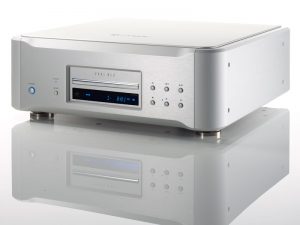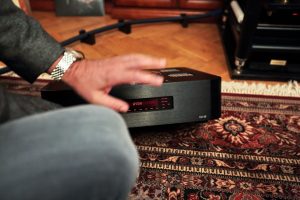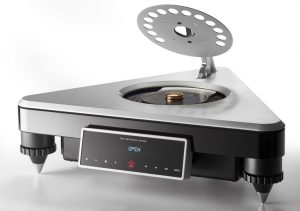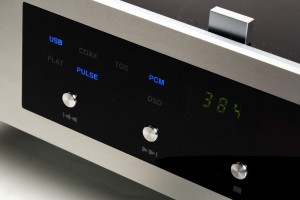
Music servers… audio streaming. Every club needs the next New Thing to survive and grow. At this juncture in the second decade of the new millennium High End audio has already got theirs.
But it sure feels like we've been here before. This is déjà vu; I'm seeing 1983, when SONY's “perfect sound forever” ad campaign broke the airwaves. Remember that hype? It took a good two decades before CD playback fixed its unmusical self. This time around, same as before, no one is talking about the 800-pound gorilla in the corner—that a well-produced physical disc on a high-res system beats the equivalent streaming or server audio file every time in terms of musical qualities, at least on the machines I've auditioned. I am not alone—most sophisticated ears I speak with agree. That is why I don't own a streaming device or a music server. As new consumer appliances, they are going to need time to mature.
These musings came to mind as I perused the website of the product under review, the Accuphase DP-720 SACD Player. In an interview with the company management team, I found the following:
“…Streaming Audio still leaves too much to be desired to meet our standards, so we will not start such a costly process yet. Besides that, there is still a lot of legitimacy for existing physical media, both in Asia and other parts of the world, so we unabatedly continue to improve those. Even today, these media have not yet reached the peak of their performance and we believe that they still sound better than what we have heard from Streaming Audio solutions.”
Yes, at this late date, many companies continue to manufacture and invest R & D dollars in CD players, with Accuphase Laboratory, the venerable Japanese High End brand, counted among them. They know their home market—this was just published in The New York Times Business on 04/15/2015: “And in several of the world's biggest markets, a majority of sales are on physical formats like CDs: In Germany, for example, the number is 70 percent, and in Japan it is 78 percent.” The Accuphase importer, Arturo Manzano, says, “CD sales are going like gangbusters in Japan.”
Don't get rid of your CDs just yet.

Some History
A couple of years ago I fell for the Accuphase DP-600 SACD Player. I remember the circumstances clearly. I had been walking the halls of the New York Audio Show 2012, weak-kneed from auditory fatigue, when I slipped into the Veloce Audio room… and lingered. During the weekend, it became a haven.
Credit goes to the Veloce amplification components. I already had review projects under discussion with them. I knew of the Accuphase DP-600 from word of mouth. This was my first hearing and it lived up to its rep. I immediately made inquiries. A review sample followed and, in no time at all, the DP-600 SACD Player became my reference.
The DP-600
All of the SACD players I had tried up to that point had issues. They took advantage of the format's density, but seemed to over-compensate for the perceived ills of first generation digital. Hence, the solid-state designs were too smooth; the tube designs were excessively euphonic.
The DP-600 was different. Here was a solid-state SACD machine that didn't put a gloss on the surface of the sound-stage. The microtonal shadings of timbre, dynamics, and tone color were present and accounted for, packaged in an attractively full-bodied “sound picture.” It was warm, rich, and musical, with a powerful low-end that caught me by surprise. When I happened to mention this low-end to the importer, he told me that the company had been consciously revoicing of late to incorporate more weight and punch. The only critique I came up with was the touch of euphony that made everything sound good. It could have been more neutral.
The DP-720
The affair lasted roughly two years until that mild euphonic coloration got to me. The incredible CH Precision D1 and C1 two-chassis digital then replaced it in the reference system. Meanwhile, the DP-600 was discontinued and Accuphase introduced a new model called the DP-720 SACD Player about a year ago. That brings us up to date.

This new machine shares many sound qualities remindful of my prior reference. In fact, with minor changes, I could take that paragraph above describing the DP-600 and drop it in right here. I would only need to spend time discussing how the DP-720 continues the company's push in the new direction.
The New Direction
That surprising power in the low end of the DP-600 that made such an impression? It's here in spades. Macro dynamics push through to a new level, assisted by a dark-hued, deeply saturated tone. Perhaps that has something to do with the physical weight of the unit, which is largely allocated between the enhanced, ultra-rigid chassis and beefed-up power supply (62 lbs. DP-720 vs. 40 lbs. DP-600).
For Accuphase, it's always about the tone. The DP-720 has even more of the big, full-bodied midrange that I had noticed in the DP-600. Frequency integration is superb. The treble is very natural and of a piece with the midrange; likewise, the lower frequencies are tightly woven to the mids.
Resolution Goes Deeper
Well, it tells you something that when panel-mate George, an analog devotee of the first rank, heard the DP-720, he extolled its smooth, natural sound. Yes, it sure is smooth. I mean totally, 100% grainless and without burrs. There is nothing irritating about this sound, but that doesn't mean it's soft. Transients are sharp-edged and move around quickly.
I'm an analog guy, too, and I can say I was impressed by how the DP-720 is able to make each instrument sound different due to fine timbral differentiation. Classical strings are marvelous.
George continued: “The DP-720 is so revealing, there's no room for mistakes. If a musician slipped up, the listener would know about it.”
That set me to wondering—there's no room for mistakes—was this critique or compliment? In my copy of the imaginary PFO Guide to High End Audio, the struggle for gains in resolution is very near the peak of our concerns. If the DP-720 plunges deep and lets you hear it all, seems to me this is virtue incarnate, especially since it comes packaged with the rich tone quality that Accuphase is known for.

We were sampling some SACDs. At the moment it was Gordon Getty - Orchestral Music (PTC 5186356, SACD). Yes, Gordon Getty, the son of J. Paul and a pretty fine composer. While his compositions don't break new ground and are derivative of Stravinsky, Copland, and Prokofiev (hey, one could do worse than that!) they are instantly ingratiating.
But mainly this SACD is a vehicle for demo-class Pentatone sound. Track 1 is very colorful, with lots of short melodies and dynamic contrasts. Large, full-bodied images pop out from all over the soundstage and my enjoyment was helped along by the DP-720s resolution and the touch of euphony it injects. (Which is present, but less pronounced than in the DP-600.) Fun stuff!
On another SACD, Invitation, featuring jazz vocalist Beat Kaestli's American Songbook standards (Chesky SACD348), large, full-bodied images again push the boundaries of the room to all corners. The stable images of the rhythm section were far left/right and actually extended outside both speakers. As for the music, you either like Beat Kaestli's voice or you don't—his is a Chet Baker kind of tenor—but there's no doubt about the quality of the recording (it's one of Chesky's finest engineering efforts), and the rhythm section, which has some of the best sidemen around. Get this SACD for those two reasons.
Confession: I just noticed I disparaged the music on these last two SACD examples. It's an occupational hazard. I spend so much time these days listening for critical purposes that the music sometimes takes a back seat.

Now I switched to Red Book. On Thomas Quasthoff - The Voice (DG 000657702), the width of the soundstage narrowed and was confined between the speakers. There was less separation of instruments, less display of timbral beauty.
The point I'm making is how variable the audio goodies are, depending on the source. The DP-720 is capable of a very pleasurable aural experience with a quality source, but it does not hide the compromised sound of many commercial productions.
Cosmetics
Accuphase components have always been recognizable by their styling and the DP-720 is right in line with the company's elegant aesthetic. Everything about it is classy, from the trademark satin gold faceplate and wood grain cabinet to the front panel display—a discreet, Calvin Klein kind of luxe.

Installation
I began with the DP-720 situated in the usual spot for visiting front-ends, atop my ELpF Vibraplane platform. For some reason, the music wasn't breathing; it didn't open up. The impression was consistently warm, rich, smooth… and closed in.
A little birdie whispered, “Take it off the ELpF” and the problem was solved. The DP-720 is the first CD player I've had that doesn't benefit from the active isolation of the ELpF. Maybe it has to do with the interesting-looking, built-in insulator feet made from high-carbon with cast iron content? Or perhaps it's the newly developed viscous dampers inside the drive?
The DP-720 was ensconced with a Kubala•Sosna Elation! power cord and alternating XLR and RCA interconnects (both balanced and single-ended analog outputs are supported) and plugged into the K•S XPander Power Distributor. I also got very good results with the new Dynamic Design Challenger digital power cord (review forthcoming).
Digital Inputs/Outputs
The DP-720 has completely separate configuration of the transport and processor sections. You can use it as a processor only and stream digital input from USB, 75-ohm coaxial, optical fiber and HS-Link. (HS-Link is Accuphase's proprietary digital audio interface and carries both SACD and CD signal.) Or use it as a transport to an external DAC via coaxial or HS-Link digital outputs. All of these are configurable via the Input Selector button on the front panel.

Technology—Specs Compared
The DP-720 was introduced a year ago and the model number alone tells you it is more ambitious than the DP-600. Apart from having the latest in-house developed transport mechanism and D/A converter, take a look at how the specs compare:
-MDSD (Multiple Double Speed DSD). A proprietary technology for noise reduction with SACD. The DP-720 has eight DACs driven in parallel vs. six in the DP-600.
-MDS++ (Multiple Delta-Sigma) type DACS for PCM signal. The PCM bit stream is sent to eight separate D/A converters that operate in parallel vs. six in the DP-600.
-Signal-to-noise ratio: 119 dB vs. 114
-Dynamic range: 116 dB vs. 110
-Channel separation 117 dB vs. 108

Conclusion
Three years ago, the Accuphase DP-600 SACD Player, now discontinued, won me over. It had the refinement and finesse the brand is renowned for, plus newfound brawn and dynamic punch. Its replacement, the DP-720 SACD Player, takes all these another leap upwards.
The DP-720 has the same acoustic timbral palette that skirts the synthetic, manufactured quality of most digital, with the kind of musical qualities found in tubed CD players—only it refrains from their excesses. Macro dynamics were particularly improved.
You can use it as a DAC for your music server via its digital inputs, but I suspect you will get most satisfaction using it as a one-box CD/SACD player.
The DP-720 is best single-box player Accuphase has made to date. There's much to like in this potent combination of qualities and it's certainly worth auditioning. If you can afford it, take the plunge.
DP-720 SACD Player
Retail: $27,000
Accuphase Laboratory, Inc
www.accuphase.com
Importer information
Axiss Distribution, Inc.
www.axissaudio.com













































